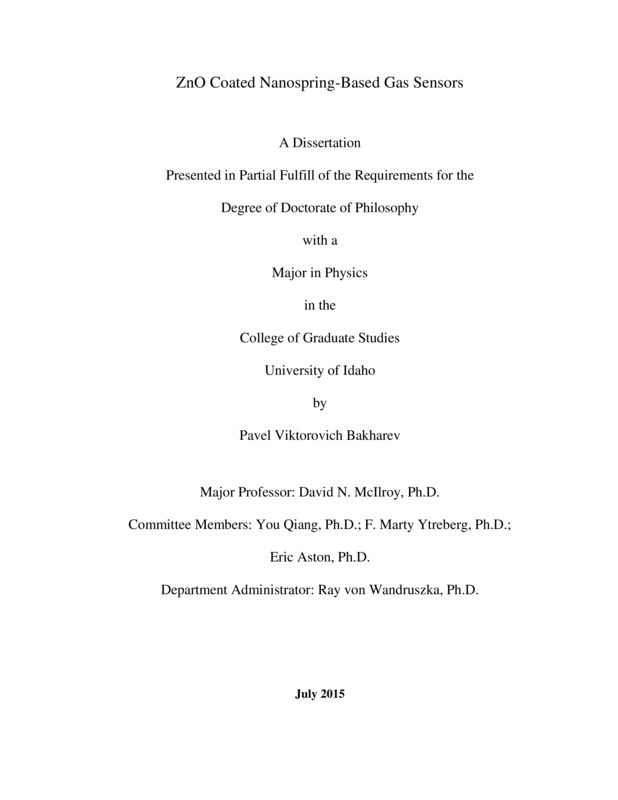ZnO Coated Nanospring-Based Gas Sensors
Bakharev, Pavel. (2015). ZnO Coated Nanospring-Based Gas Sensors. Theses and Dissertations Collection, University of Idaho Library Digital Collections. https://www.lib.uidaho.edu/digital/etd/items/bakharev_idaho_0089e_10697.html
- Title:
- ZnO Coated Nanospring-Based Gas Sensors
- Author:
- Bakharev, Pavel
- Date:
- 2015
- Keywords:
- ALD CVD MOS Sensors Nanosprings Thin Films ZnO
- Program:
- Physics
- Subject Category:
- Condensed matter physics
- Abstract:
-
The current research demonstrates new techniques for characterization of electrical transport properties of the metal oxide polycrystalline structures, gas and vapor phase kinetics, surface processes such as gas-surface, vapor-surface interactions and redox processes by applying novel gas sensing devices. Real-time sensor electrical response characteristics obtained under highly controlled laboratory conditions have been used to characterize corresponding surface interactions and electrical properties of the gas sensitive structures. Novel redox chemical sensors (chemiresistors) have been fabricated with 3-D and 1-D ZnO coated nanospring (NS) structures. Silica NSs served as insulating scaffolding for a ZnO gas sensitive layer and has been grown via a vapor-liquid-solid (VLS) mechanism by using a chemical vapor deposition (CVD) technique. The NSs have been coated with polycrystalline ZnO by atomic layer deposition (ALD). The chemiresistor devices have been thoroughly characterized in terms of their crystal structures (by XRD, FESEM, TEM, and ellipsometry) and their electrical response properties. A 3-D gas sensor has been constructed from a xenon light bulb by coating it with a 3-D zinc oxide coated silica nanospring mat, where the xenon light bulb served as a sensor heater. This inexpensive sensor platform has been used to characterize gas-solid, vapor-solid, and redox processes. The optimal temperature of the gas sensitive ZnO layer, the temperature of the vapor-gas mixture and the crystal structure of the gas sensitive layer have been determined to reach the highest sensitivity of the gas sensors. The activation energy of toluene oxidation (Ed) on the ZnO surface and the activation energy of oxidation (Ea) of the depleted ZnO surface have been determined and analyzed. A 1-D chemiresistor has been fabricated with a single ZnO coated silica nanospring by photolithography. The question of sensor sensitivity of MOS nanomaterials and MOS thin films has been addressed. The experimental and computational analyses of the sensing properties of the 3-D (nanospring-based) and flat thin films structures show that the complexity and periodic boundary conditions of the nanospring-based devices result in a lower detection limit, while flat thin films exhibit higher sensitivity to small analyte concentration fluctuations. Our analysis shows that the productive approach to fabrication of integrated sensors (electronic noses) is to use both the structures (3D and flat geometries) as the receptors for a prompt and reliable detection and recognition of the target chemical compounds. Analog lock-in amplifier (LIA) AC measurements of the electrical response have been performed to significantly improve the signal-to-noise ratio (SNR) and reduce the detection limit of the single ZnO coated nanospring chemiresistor from the ppm to the ppb analyte concentration ranges. The LIA-based sensor signal recognition technique has shown to extend the capabilities of the gas sensor array for a linear discrimination analysis (LDA), an independent component analysis (ICA), a principal component analysis (PCA) and other multiple odor recognition methods.
- Description:
- doctoral, Ph.D., Physics -- University of Idaho - College of Graduate Studies, 2015
- Major Professor:
- McIlroy, David N
- Committee:
- Qiang, You; Ytreberg, Marty; Aston, Eric
- Defense Date:
- 2015
- Identifier:
- Bakharev_idaho_0089E_10697
- Type:
- Text
- Format Original:
- Format:
- application/pdf
- Rights:
- In Copyright - Educational Use Permitted. For more information, please contact University of Idaho Library Special Collections and Archives Department at libspec@uidaho.edu.
- Standardized Rights:
- http://rightsstatements.org/vocab/InC-EDU/1.0/

